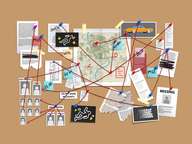It has been over half a year since the last release. I had some thoughts about a core mechanic and did overhaul it completely.
Changes are described below and some random thoughts on why these changes happened.
If you want to skip this and just get to the rules, click here.
Investigation
As teased, the major overhaul of the system was the investigation. Time and time again I come back to my playtest and see what didn't work there. This system was a big part of it. It was too complicated and even I didn't understand it after a while. I had to simplify the rules and align it more to my vision.
It is interesting on how some things go back to their roots. In earlier iterations I had big questions that needed answering. Previously they were a bit freeform and that is why I scraped them in the next version very quickly. So I wanted to give them a bit more structure. I'd seen some playthroughs of the Sherlock Holmes video games, especially the later ones. In it you would gather clues and then you had to find the correct clues to form a node in your deduction board.
I have already a system to get clues. They are nothing more than aspects. And so far it doesn't diverge much from what I had before. However gone are the focus tables. The player themselves are choosing on what they want to do. And in most cases it will be gathering clues anyway. So clues and suspects are somewhat "free" to create. When you roll to create aspect you can get a clue out of it (basically when the action was aimed at gathering clues, like interogating a suspect or something). Previously you could sometimes get a clue out of it sometimes not. And the player is technically still free to just create a clue if it makes sense in the story (as it is with all stories).
The final part comes in the form of how conclusions are then made. There's an interesting concept of riddle and tilt that has been proposed as sort of design pattern by other designers. And I had something similar already for the Notice and Scene Complications. Basically clues become a meta-currency you can spend to improve your roll to successfully draw a conclusion. So now it becomes clear on how the player needs to progress: gather clues and then draw conclusion. Other games, which I have mentioned, use a similar approach, like Brindlewood Bay. The clues act as a sort of prompt for the conclusion as well.
Additionally I can have the player connect everything with lines and evoke the picture with the corkboard deduction. It all fits together nicely now.
On top of that I was able to "gameify" the showdown a bit more. I always wanted it to be a Scene Challenge. What eluded me a bit was on how the parameters of the challenge are affected from your investigation. I think I now have found a system that makes both mechanical and thematic sense. The idea is to check on how well connected the conclusions are to the suspects. If multiple suspects are invovled, the investigation is a bit shaky and the conclusions might be wrong, so the challenge will be harder. On the other hand, if everything points to the same person the case is crystal clear and can be resolved easily. Maybe.
Miscellaneous
Some other small things that have changed.
Scene Complication now happens on a 7+ instead of an 8+. This is to bring it in line with drawing conclusions, that also happens on a 7+. There should be only one value for the same mechanic, otherwise the player will get confused. This makes Scene Complications more common and you do not get a "free" Notice anymore.
Character and Case Sheet now include some (hopefully) helpful reminder texts. The player should be able to gauge all the neccessary rules to play from these sheets so that interrupts are kept to a minimum.
And in case you've missed it. There's now a logo.
Outlook
Should the new investigation mechanic now hold, there only remains one big thing to tackle: character creation and progression. As mentioned before there are some ideas, but nothing is concrete yet. The game is playable right now, the options are limited but it is still in its design phase.

